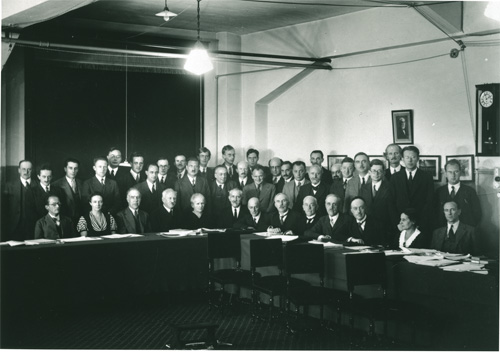Milestones on the path of scientific progress
From 1996 to 1998, the centennial of the discovery of radioactivity was celebrated in France. Exhibitions were held, meetings took place, films were shown and symposia were organized. The opportunity was also taken to inform the general public of the consequences of this major discovery; the resulting improved understanding of the atomic structure, and the improvements to our quality of life this understanding has brought.

The 1933 Solvay Physics Conference:
Predecessors of modern physics conventions, the Solvay conferences started in 1911 and brought together some of the greatest scientists of the age. The seventh conference, held in Brussels in 1933, was the last such meeting attended byMarie Curie. Under the chairmanship of Paul Langevin, the assembled physicists discussed the implications of Chadwick’s discovery of the neutron. One year later it was the discovery of artificial radioactivity by the Joliot-Curie.
© ACJC
At the turn of the last century and before the discovery of radioactivity, the atom remained an hypothetical concept, whose very existence was not proved. It was only in 1906 that the French physicist Jean Perrin was conclusively able to demonstrate this existence.
Marie Curie and her husband Pierre, curious about what was happening inside the atom, postulated that radioactivity was an atomic phenomenon. In a world where the atom was held to be a fundamental, indivisible unit of matter, the proposal that an atom was capable of decaying or of transforming amounted to heresy.
The following decades saw very many great experimentalists attempting to discover the true nature of the atom. Using the newly-discovered phenomenon of radioactivity, they were able to deduce that an atom consisted of an extremely dense central nucleus surrounded by orbiting electrons. Further experimentation revealed even more fundamental units of matter: the nucleus consists of protons and neutrons bound together very tightly, and both neutrons and protons are composed of even smaller elementary particles, the “quarks”. At around the same time, physicists proposed the existence of a particle they called the ‘neutrino’; for which no direct evidence was found during decades. The neutrino was exprimentally discovered 25 years later, as predicted.
A Page of History : Vidéo – Source Ganil
All this work being done on the atom revealed the existence of a fundamental force, the weak interaction, that had previously gone unnoticed before the discovery of beta radioactivity. The weak interaction is seen today as a force that occurs between particles when they exchange ‘W’ or ‘Z’ bosons. Experiments at CERN provided in 1982 evidence for these hypothesized particles, which finally answered the question asked some 80 years previously: “Where does radioactivity come from?”
In parallel to all of these experimental discoveries, a large number of possible applications of radioactivity were revealed. These ranged across all fields, from the generation of energy to the treatment of cancer to the production of nuclear weapons. The harnessing of the power of radiation is undoubtedly one of humanity’s greatest intellectual achievements.
A few key dates after the first discoveries
– 1934 Commissioning of the first cyclotron at Berkeley
– 1937 Muon discovery among cosmic rays
– 1951 Beginning of positon emission tomography
– 1954 Creation of the largest particle physics center in the world, CERN near Geneva
– 1954-56 Antiproton and antineutron discoveries at the Berkely Bevatron
– 1957 Start-up of the synchrocyclotron, CERN’s first major accelerator
– 1962 Discovery of the muon neutrino
– 1974 Discovery of the J/Psi, a particle containing a new species of heavy quarks called charmed
– 1983 Experimental discoveries at CERN of the W and Z° bosons involved in weak interactions
Access to page in french
Articles on the subject « Discoveries »
Three radiations
Understanding the nature of alpha, beta and gamma rays In the years following the discovery of ra[...]
Discovery of the Nucleus
A new vision of the atom In 1911, Rutherford, Marsden and Geiger discovered the dense atomic nucl[...]
Ernest Rutherford
In October 1895, landed in England a 24 years-old young New Zealander. His name was Ernest Ruther[...]
Rutherford’s experiment
The experiment which proved the existence of a nucleus in the atom In 1908, Ernest Rutherford rec[...]
The neutron : Chadwick
A close competition between great physicists … James Chadwick, who discovered the neutron i[...]
Radium and Medicine
A short history: first steps in nuclear medicine … Everyone knows that the discovery of rad[...]
1934 : Artificial Radioactivity
The production at will of radioactive isotopes In the first days of 1934, Frederic and Irene Joli[...]
The Neutrino Hypothesis
The remarkable story of the neutrino The study of radioactive disintegrations had established tha[...]
Fission discovery
A nuclear phenomenon that escaped the hands of physicists In the years spanning 1934 to 1938, Enr[...]
Enrico Fermi
A genial experimenter and theoretician Enrico Fermi (Rome, September 29, 1901 – Chicago, No[...]